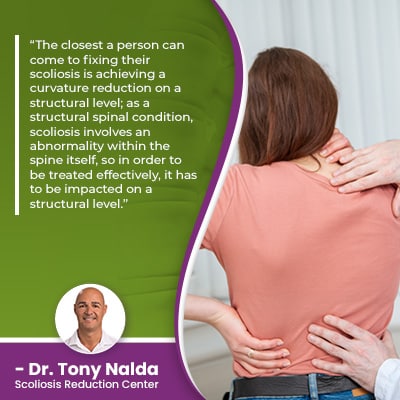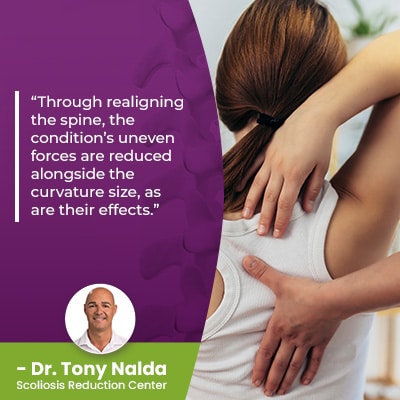Progressive conditions have it in their nature to get worse over time, which is why sometimes when treatment is started can be almost as important as the type of treatment started. When we’re talking about spinal health and function, a loss of the spine’s healthy curves, caused by scoliosis, can have far-reaching effects, which is why proactive treatment is so important.
As a progressive condition, scoliosis is incurable, but it can be highly treatable. Scoliosis can’t be fixed permanently, meaning cured, but if treated proactively with a conservative treatment approach, a diagnosis of scoliosis doesn’t have to limit or define a person.
The journey of scoliosis-treatment starts with a diagnosis, so let’s start with how scoliosis is diagnosed.
How is Scoliosis Diagnosed?
Scoliosis is a highly-prevalent structural spinal condition that involves the development of an unnatural sideways spinal curve that also twists, making it a complex 3-dimensional condition.
Scoliosis is also a progressive condition whose nature is to get worse over time, and this means that where a scoliosis is at the time of diagnosis isn’t indicative of where it will stay; only proactive treatment can work towards counteracting the condition’s progressive nature.
Scoliosis ranges widely in severity from mild to moderate and severe to very severe, and this is also the condition’s progressive line; in most cases of scoliosis, we don’t fully understand what triggers the initial onset, but we do know that it’s growth and development that triggers it to progress.
So when treating childhood scoliosis, a focus of treatment is monitoring for rapid progression, but when treating scoliosis in adults, the focus is more on stabilizing the spine.
A patient’s Cobb angle is a key piece of information that treatment plans are shaped around, and it’s a measurement taken during X-ray that tells me how far out of alignment the spine is, and the more severe a condition, the more complex it is to treat and the more likely it is that its effects are going to be overt.
So when it comes to fixing scoliosis, as a progressive condition, there is no permanent cure, but when responded to proactively, and particularly with early detection, there can be fewer limits to what can be achieved; however, there are no treatment guarantees.
So let’s move on to the different types of scoliosis and their treatment needs.
Different Types of Scoliosis
Part of diagnosing scoliosis involves further assessment so conditions can be classified based on key patient/condition variables; this helps streamline the treatment process.
No two cases of scoliosis are the same; the highly-variable and complex nature of the condition necessitates the customization of effective treatment plans.
Condition type is an important classificiaton-point, and this is determined by causation.
Now, in the vast majority of known diagnosed scoliosis cases, the cause is unknown, and this is idiopathic scoliosis; there are a number of theories attempting to account for the development of idiopathic scoliosis, but a single-known cause has yet to be identified.
Approximately 80 percent of known causes are idiopathic, and the remaining 20 percent are associated with known causes: neuromuscular scoliosis, congenital scoliosis , and degenerative scoliosis.
As idiopathic scoliosis is the most prevalent type to affect all ages, let’s focus on the topic of fixing idiopathic scoliosis.
The most common type of scoliosis overall is adolescent idiopathic scoliosis, diagnosed between the ages of 10 and 18, and this age group is the most at risk for rapid-phase progression because of the rapid and unpredictable growth spurts of puberty.
When rapid progression is a risk, being proactive with treatment is particularly important because the more a condition progresses, the more likely it is to continue to do so, and the more complex it gets to treat.
Let’s now address how scoliosis can be treated proactively and managed effectively because how a diagnosis is responded to with treatment shapes a person’s long-term spinal health and function.
How to Treat Scoliosis Effectively

When it comes to minimizing the effects of scoliosis, it’s all about the type of treatment that’s chosen, and when it’s started.
There are two main scoliosis treatment approaches, and each affects long-term spinal health and function differently, so patients need to be aware of all treatment options available to them, along with their effects.
The closest a person can come to fixing their scoliosis is achieving a curvature reduction on a structural level; as a structural spinal condition, scoliosis involves an abnormality within the spine itself, so in order to be treated effectively, it has to be impacted on a structural level.
Traditional scoliosis treatment tends to be more reactive than proactive; it doesn’t have a strategy for treating scoliosis while mild so does little to prevent progression, but responds with a surgical recommendation when/if patients progress into the severe classification.
Conservative scoliosis treatment offers a proactive response as it starts treatment as close to the time of diagnosis as possible, and when mild, scoliosis is likely to be at its most responsive to treatment.
Here at the Scoliosis Reduction Center®, patients benefit from a conservative approach that works towards preventing progression, increasing condition effects, and the need for invasive surgical treatment in the future.
Conservative treatment is integrative; it combines multiple scoliosis-specific treatment disciplines to impact conditions on every level and to facilitate the complete customization of every treatment plan.
Chiropractic Care
As a CLEAR-certified scoliosis chiropractor, I know the spine; I know how scoliosis affects it and how scoliosis responds to treatment.
Through a series of chiropractic techniques and manual adjustments, I can work towards repositioning the curve’s most-tilted vertebrae back into alignment with the rest of the spine, thus restoring as much of the spine’s healthy curves as possible.
Through realigning the spine, the condition’s uneven forces are reduced alongside the curvature size, as are their effects.
Chiropractic care can impact the condition on a structural level, and once I see structural results, I can start focusing on other aspects of the condition and treatment.
The Power of Physical Therapy and Scoliosis-Specific Exercises (SSEs)
Once a curvature reduction is being achieved, I can shift the focus to increasing core strength, and this is because it’s not just the spine that’s in charge of maintaining its natural curves and alignment, but also its surrounding muscles.
Through physical therapy and the prescription of scoliosis-specific exercises, the back and abdominal muscles can be strengthened and balanced so they are better able to optimally support and stabilize the spine.
Physical therapy can also help improve posture and stimulate specific areas of the brain for improved brain-body communication.
Corrective Bracing

There are a number of shortfalls associated with traditional scoliosis bracing, but modern corrective scoliosis bracing can be a valuable facet of treatment.
Bracing is also particularly effective on growing spines, so is commonly used in the treatment of childhood scoliosis.
The ultra-corrective ScoliBrace is often my brace of choice here at the Center because it can augment corrective treatment results by pushing the spine into a corrective position.
Rehabilitation
When it comes to rehabilitation, this is about sustaining treatment results for the long term; remember, scoliosis isn’t curable, only treatable, so continued effort is needed to sustain treatment results.
Continued chiropractic care can help ensure the curvature reduction is held, and a series of custom-prescribed home exercises designed to further heal and stabilize the spine can help patients establish a home-rehabilitation program.
Conclusion
While there is no way to fix scoliosis permanently, it can be managed effectively through a proactive treatment approach.
There was a time when a diagnosis of scoliosis was thought to mean a life of limitation, but we have since learned enough about the condition, and different types of treatment, to know this doesn’t have to be the case.
In fact, many people don’t just survive a life with scoliosis, they thrive; the number of famous celebrities, athletes, and musicians that went on to fulfill their dreams despite having scoliosis can help motivate and inspire young patients.
Here at the Center, I believe in a proactive treatment response, and that means starting treatment as close to the time of diagnosis as possible.
Remember, as a progressive condition, there is no way to know how bad scoliosis can get, but there is a way to manage its effects, and the best way to minimize the effects of scoliosis is to prevent progression through a proactive treatment response.
It’s never too late to start scoliosis treatment, and the best time to start treatment is always now.




